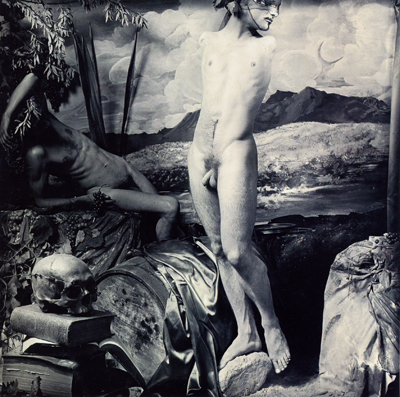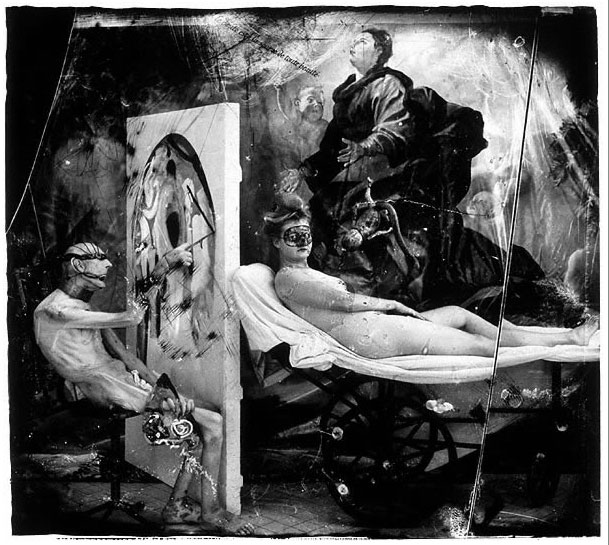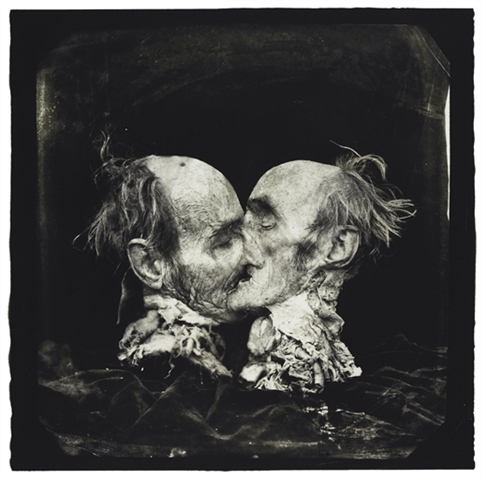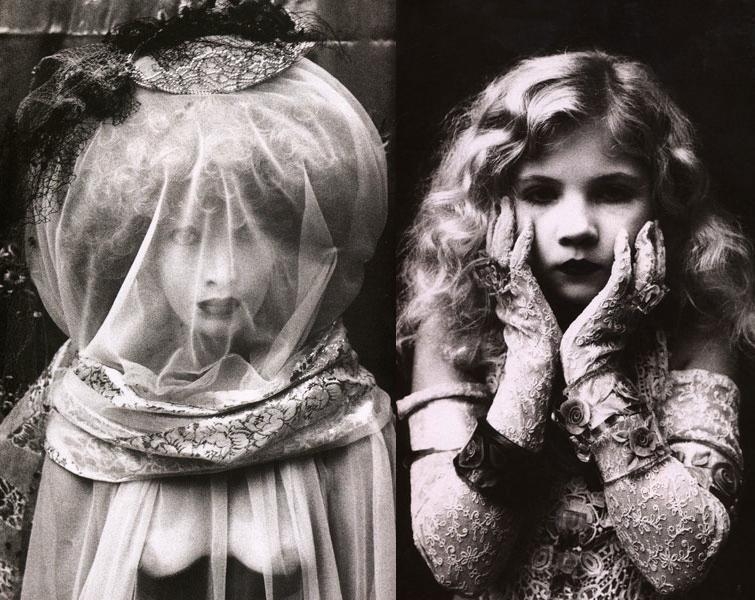Sprinkle a bit of holy water. throw some ash over he shoulder and maybe keep a little pepper spray in the frock. A tragic morbidity that seems to romanticize violence even as it masquerades ostensibly as a critique, maybe a reflection of the impulsive id tormented beyond desire and anguished within the grotesque as confrontational. A morbidity beyond redemption. There probably is some plausible, incontrovertible truth in Freud’s assertion that a work of art is in large measure a sublimation of desire, a proxy expression of wish fulfillment.

---Joel-Peter Witkin is an artist who actually works directly with death – some of his morbid tableaux feature actual corpses or body parts. His scratched, distressed photographs look as though they are rediscovered crime scene evidence from a Victorian era horror. Nude men and women mix with animal parts, masks, random bits of machinery, severed limbs, or bowls of fruit. Some of his works are borderline pornographic; most are deeply disturbing.--- Read More:http://themorbidimagination.com/art/joel-peter-witkin/ Image:http://brucesilverstein.com/galleries.php?gid=283&i=3&page=next
Is all this morbidity a kind of sly invitation to intimacy? A complicity in the voyeuristic? It seems like a fascination with degraded substances as well as a desire and wish to make a spectacle of oneself, a sensation in the neo-Dada sense of the nihilistic narcissist. A tragic morbidity that seems, ultimately, to romanticize violence while promoting itself as critique. It’s hard to be overly generous to a Serrano, Silverthorne or Witkin, especially when one questions how full or empty the tank is of emotional credentials and looking through the rear-view mirror of how backward looking the mental state is. There is a dialectic of the grotesque, understandable as a play on the absurd, trying to reconcile itself through post-modern pop and avant-garde hip that may only be attainable through a narrative of death.

---Joel-Peter Witkin "Poussin in Hell" 1999 Joel-Peter Witkin's photographs seem like vintage pieces, but they are, in fact, contemporary. Witkin's vision is a bit horrific, and dense with beauty and psychological tension. --- Read More:http://www.phantasmaphile.com/2007/06/joelpeter_witki.html
From Diane Arbus, to Silverthorne, even Sander, to Witkin, modern photographic arts use infirmity and deformity that represent the odd as an encumbrance of life. An inherent condition. At the other extreme, the young and beautiful, are also revealing in the burden of the carnal, a conforming behavior that accompanies such spectacularized beauty. In either way, there is always a fragility of the corporeal, a movement within transparent packaging, where moments of triumph and defeat balance on a tightrope known as the inevitability of destruction….
Goodwin: Witkin obviously holds mystical views on the bodily fact of death, as exemplified in his statement “Knowledge goes beyond the physical. At the moment of death there’s bodyweight loss, and that supposedly can mean the ascension of the spirit.” Witkin believes himself to be an emissary on behalf of such transformation: “I have consecrated my life to changing matter into spirit with the hope of someday seeing it all. Seeing its total form, while wearing the mask, from the distance of death.” …

---Charles Mann:Joel-Peter Witkin has been called ‘part Hieronymous Bosch, part Chainsaw Massacre.’ His photographic tableaux, carefully arranged and painstakingly printed, offer us the chance to transcend subject matter, and enter what Witkin calls a world of ‘love and redemption’."...If all creation can be said to be godlike, then the creation of these images assumes a spiritual quality most readily sensed in Witkin’s images that use cadavers and body parts. Witkin, in photographing the dead, brings their quickening essence once again to movement and expression, takes what we would ordinarily dismiss as the past, and enlivens it. In this way, what these cadavers achieve is nothing short of a new life, another chance to commune with the living, and even more striking, a chance for the living to commune with the dead....Read More:http://www.zonezero.com/exposiciones/fotografos/witkin2/state.html image:http://www.zonezero.com/exposiciones/fotografos/witkin2/state.html
…With many of his images of the dead it is impossible to comprehend how even Witkin could imagine that a transmutation of flesh into spirit takes place through photography. The Kiss (1982), to take just one example, was a result of an unexpected discovery Witkin made while posing the severed head of an old man. An anatomist at the medical school that provided the specimen had completely bisected the head so that Witkin could place one side of the face mouth to mouth with the other side. Far from any spiritual mystery and apart from its shock value, the whole composition basically offers a crude art history joke on the famous sculptures created by Auguste Rodin and Constantin Brancusi.Read More:http://www.ohiostatepress.org/books/Book%20PDFs/Goodwin%20Modern.pdf
ADDENDUM:
Wayne Owens:It was Duchamp who deliberately projected a sort of baffling double-mindedness onto his notoriously ordinary objects; who attempted to seduce the observer into the fantasy notion that his works of art were all and nothing at once—a simultaneous degradation-exaltation radiating from an elusive center which would vanish the instant it was conceptually apprehended.
Can one see such objects both ways—as everyday artifacts and elegant works of art simultaneously? That is exactly how Duchamp would like us to see his readymades. They have a double identity. They are socially functional artifacts that have been changed into sublime artistic masterpieces by the creative act of Duchamps’ psyche. But they retain their everyday functionality; they revert to it in the blink of a creative eye, or rather in the mind. In short, they embody aesthetic osmosis while remaining inert matter. Supremely ambiguous, they are supremely perverse; that is, they blur the difference between art and non-art, an act of differentiation all too often regarded as the gist of modern creativity. The tantalizing ambiguity that is the readymade precludes aesthetic idealization. When The Fountain, (1917) was praised as beautiful and tasteful, as occurred when it entered the museum, Duchamp became angry, for it was understood exclusively on the aesthetic plane, whic
stroyed its confused identity as art/non-art, that is, mentally art, physically non-art.
---At the tender age of 5, Eva was her mother’s favorite model. She is the youngest model ever to appear in a Playboy nude pictorial, since she was featured at age 11 in the October 1976 issue of the Italian edition of the magazine in a set by Bourboulon. Irina’s erotic photographs of her daughter have been a source of controversy since they first appeared in the 1970s.--- Read More:http://grimm-love.blogspot.com/?zx=35826c511ec2458b
It was Duchamp’s attempt to dismiss the aesthetic responsibilities of the artist be feigning a sort of sublime indifference to it—by leeching it of emotion—and by therefore suggesting that a crippling ambiguity is the actual source-condition of existence; that indeed a kind of elemental confusion is the native and eternal condition of mankind. Duchamp intended to strike at the very heart of art itself, by denigrating aesthetics as a farcical absurdity. It is Duchamps’s insistence on a primal ambiguity that exposes his loveless nihilism—he retreated to the rigors of chess after relegating art to a sort of secondary concern—as well as his need to lay waste to the totality of culture which had come before him. Indeed Duchamp’s methods seem to embody what Blake decried as “ a pretence of Art to destroy Art” which has, not surprisingly, devolved over the decades into what Kuspit now dismisses as anti-art, or postart, or mere commercial entertainment and creative degradation. Read More:http://www.dharmacafe.com/culture-arts/postmortem-on-postmodern-art/full/





 COMMENTS
COMMENTS